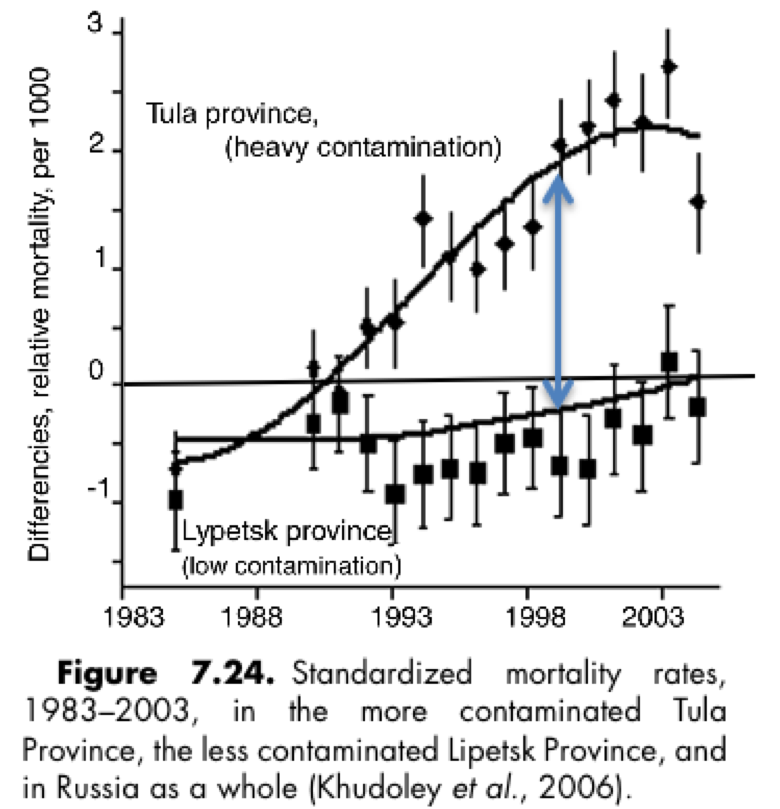• • •
"Mike and Jon, Jon and Mike—I've known them both for years, and, clearly, one of them is very funny. As for the other: truly one of the great hangers-on of our time."—Steve Bodow, head writer, The Daily Show
•
"Who can really judge what's funny? If humor is a subjective medium, then can there be something that is really and truly hilarious? Me. This book."—Daniel Handler, author, Adverbs, and personal representative of Lemony Snicket
•
"The good news: I thought Our Kampf was consistently hilarious. The bad news: I’m the guy who wrote Monkeybone."—Sam Hamm, screenwriter, Batman, Batman Returns, and Homecoming
July 07, 2011
Chernobyl: Health Statistics for Adults, and a Counterfactual
By: Aaron Datesman
Many of the source documents referenced in Yablokov et al. (the NYAS Chernobyl report) may be found by poking around on the internet, which in this case is a highly worthwhile exercise. For instance, it's rather easy to locate a source for the chart in this post describing the juvenile morbidity in Gomel. The report is a product of the German Society for Radiation Protection (GFS) and the German affiliate of International Physicians for the Prevention of Nuclear War (IPPNW).
Having examined juvenile morbidity in one highly-contaminated region of Belarus, I agree that it's important to ask as well what the health outcomes have been for adults living in contaminated areas. The information below comes from page 62 of the GFS/IPPNW report.

The ultimate source for these statistics is Dr. Angelina Nyagu of Ukraine, whose biography indicates singular experience in the field of health effects due to the Chernobyl disaster. Dr. Nyagu's presentation at the April 2011 IPPNW Congress is available at this link, in case you are interested to learn more.
While these health statistics are quite frightening (the statistics for children of exposed parents especially), it's quite correct to note that this information includes no counterfactual. This is a substantial concern because, without health statistics representing an unexposed control population, it's impossible to disentangle negative health effects due to social and political instability in the Soviet Union circa 1990 from the negative health effects due to the Chernobyl disaster.
This information does exist, although I do agree that it doesn't get very prominent presentation in Yablokov et al., or in other studies released by anti-nuclear groups and cited by activists. It is possible to view this state of affairs as an attempt to create a non-existent causal relationship using an avalanche of data showing correlation without establishing cause. This is a reasonable critique up to a point, in my opinion, but in the case of the Chernobyl disaster it generally fails to pass the test of common sense.
There is a more basic explanation, however: robust, large-scale epidemiological studies are hellishly expensive. With the Soviet Union in a state of sustained upheaval and collapse in the years after the Chernobyl meltdown, who would have paid for suitable control studies? Furthermore, given the incentives to disguise the degree of harm which occurred (whatever it might have been), why would they have done so?
Nevertheless, counterfactual evaluations do exist. One such study is summarized in the graph below, taken from Yablokov et al. I cannot find the original reference (which is a Russian-language document, commissioned by Greenpeace) on the web, but the author appears to be Veniamin Khudolei of the Center for Independent Environmental Assessment of the Russian Academy of Sciences. (This article discusses the 2006 Greenpeace report which utilized the data shown below and was responsible, in turn, for the NYAS Chernobyl publication.)

Figure 7.24 displays the relative rates of mortality (per 1000 - that's 100 per 100,000, which is the more usual unit) in two areas of Russia contaminated by fallout from Chernobyl. In each year, the raw statistics have been adjusted (normalized) so that the value for Russia overall is zero, as indicated by the horizontal line. The graph therefore indicates that, prior to the Chernobyl disaster, the inhabitants of both Tula and Lypetsk a) enjoyed about equal mortality rates, and b) suffered less mortality than the population of Russia as a whole. Post-Chernobyl, mortality in both regions increased significantly with respect to the Russian baseline, with a much larger effect observed in Tula, which was more heavily contaminated.
A quantitative interpretation is also available. Starting in 1988, when the mortality rates in Tula and Lypetsk were identical, according to the figure an excess mortality emerges in Tula given by the length of the vertical blue line. By eyeball, on average the length of this line is about one unit, representing one death per year per 1000 population. Over the 25 years from 1998-2003, then, the excess mortality in Tula comes to 2.5% of the entire population of that contaminated region. (The actual value, more properly given by an integral representing the area between the curves, is 3.75% from 1990 to 2004).
According to Yablokov et al., that's 60,400 deaths in Tula alone.
Of course, I can't even locate Tula and Lypetsk on a map, so I have no idea whether the author of this study is performing the sort of sleight-of-hand I would call out if he were comparing health outcomes between Massachusetts and Mississippi. To my knowledge, however, those agencies and persons who dismiss the conclusions of Yablokov et al. do not do so from a foundation of deep knowledge regarding the demographics, geography, and health characteristics of the former Soviet Union. Given the obvious cultural, language, and political barriers to full communication regarding the effects of the Chernobyl disaster which exist, it is not apparent to me why the sensible conclusions of Russian health researchers and scientists can be blithely dismissed.
— Aaron Datesman
In answer to your admitted ignorance, Tula and Lipetsk are indeed more or less reasonably comparable regions. In fact, if anything Tula would be expected to be closer to the "Massachusetts" of your example, since it directly borders Moscow oblast, while Lipetsk does not (in fact, it borders Tula oblast). That alone means that Tula is at least marginally more wealthy and its residents have access to at least marginally better care.
Posted by: JMM at July 7, 2011 09:38 PMI wonder if Chernobyl had a roof top swiming pool for spent fuel, also?
Posted by: Mike Meyer at July 8, 2011 04:05 AMIt seems that sanity gets lost in the details sometimes.
Posted by: Dredd at July 8, 2011 10:03 AMFascinating again Aaron, grazzi.
You wrote: "it is not apparent to me why the sensible conclusions of Russian health researchers and scientists can be blithely dismissed."
Chorus: Follow the social-economic motive.
Posted by: N E at July 8, 2011 01:33 PMThe word "healthy" is certainly fuzzy.
I chimed in on a previous thread about the mortality of infants in the NW. My simple question was about the causes and or a causal link. Low or moderate level radiation exposure to my knowledge has no possible mechanism for causing death in the short term.
I could be wrong but I would like to hear of any possible causal relationship between short term exposure to low level radiation and infant fatalities.
I've got no ax to grind and am not debunking anything. However without any plausible explanation for radiations causation in the deaths I am afraid that this sort of information could prove counter productive.
Posted by: rapier at July 9, 2011 09:40 AM@rapier -
Sure, "healthy" is fuzzy. But you can click on the link to Dr. Nyagu's presentation, and go on from there to read the Greenpeace report, &c, for clarification.
I understand what you're asking, but a) I don't find it hard to imagine, since in very young children the rate of cell division is extremely high, and b) I think you've got the nature of scientific investigation backward in any event.
Regarding a), it's generally accepted today (although once it was not) that pregnant women should not have abdominal X-rays. This is because of the risk of harm to the fetus from the dose of X-ray radiation. Nevertheless, we hear all the time "as safe as an X-ray".
Regarding b), what we have is a theory (really, a set of theories) about the health risks of radiation exposure - that radiation causes cancer, that high doses destroy the GI tract, etc. But where that theory collides with observation, it's the theory that has to yield. Nature is the final arbiter, not our abstractions of it.
As it happens, the Sherman/Mangano conclusions I posted are wrong. I will post about this later this weekend.
http://www.thebulletin.org/files/May-June%201996_Chernobyl-Sich.pdf
Posted by: Amandasaurus at July 9, 2011 02:40 PMAnd yet still do not want to live any where near a nuclear plant no matter what the russians say.
Posted by: Edward at July 9, 2011 10:54 PM


